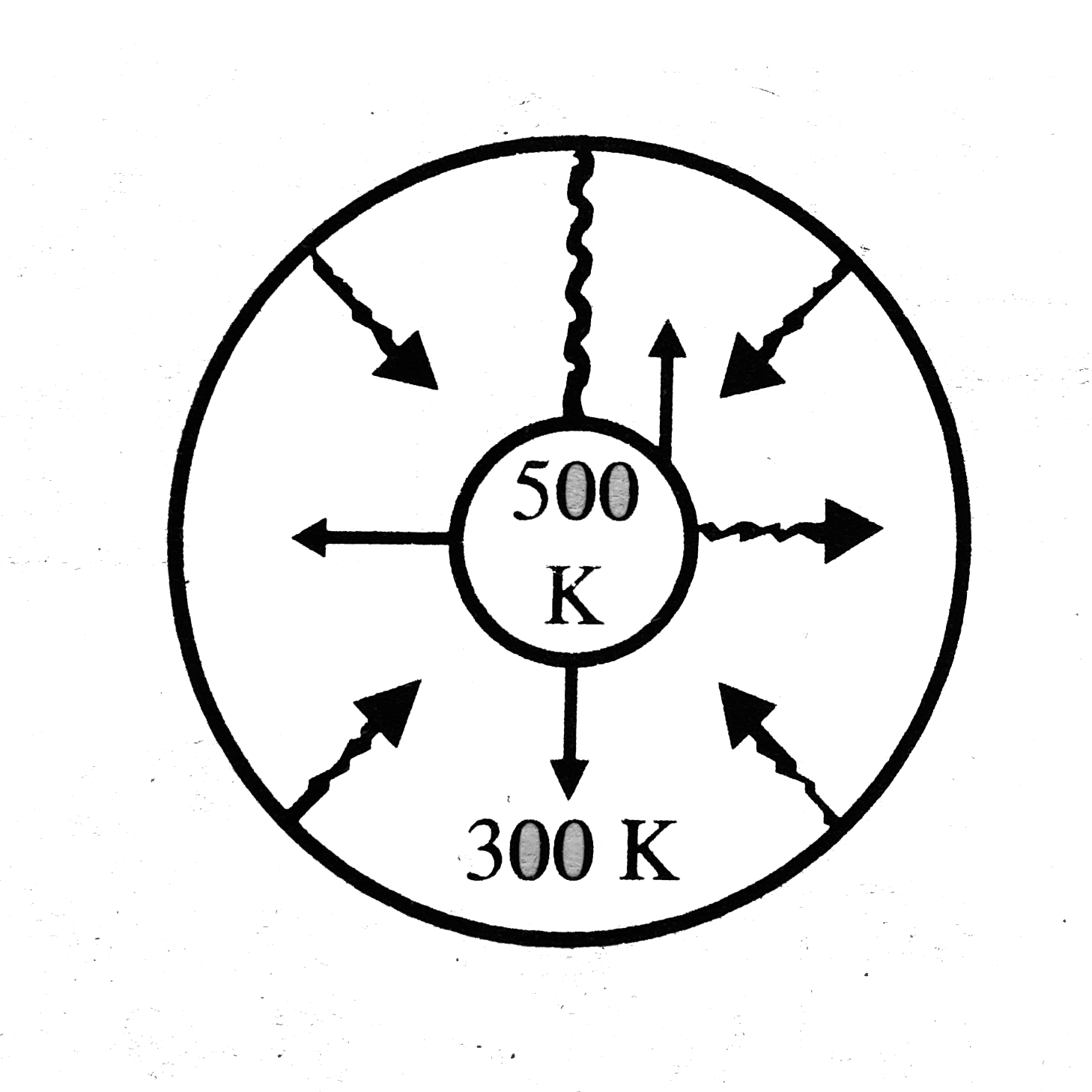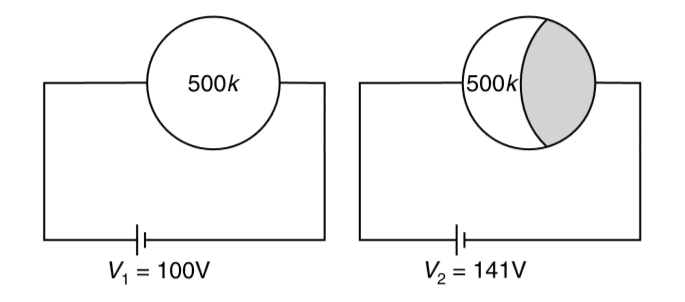
A copper sphere is suspended in an evacuated chamber maintained at 300 K. The sphere is maintained at a constant temperature of 500 K by heating it electrically. A total of 210 W of electric power is needed to do it. When the surface of the copper sphere is completely blackened, 700 W is needed to maintain the same temperature of the sphere. Calculate the emissivity of copper.
0.3
0.2
0.5
None of these
The correct Answer is:A
Let e be the emissivity of the sphere. Then by Stefan's law
E=eσA(T4−T40)
210=eσA(5004−3004) ..(i)
When sphere is blackened, it behaves like a perfectly black body, so we have
700=σA(5004−3004) ..(ii)
Dividing Eq. (i) by Eq. (ii), we get e=0.3.
Topper's Solved these Questions
- BOOK - CENGAGE PHYSICSCHAPTER - CALORIMETRYEXERCISE - Exercise 1.123videos
CALORIMETRY
- BOOK - CENGAGE PHYSICSCHAPTER - CALORIMETRYEXERCISE - Exercise 1.222videos
CALORIMETRY
- BOOK - CENGAGE PHYSICSCHAPTER - BASIC MATHEMATICSEXERCISE - Exercise 2.620videos
BASIC MATHEMATICS
- BOOK - CENGAGE PHYSICSCHAPTER - CENTRE OF MASSEXERCISE - INTEGER_TYPE1videos
CENTRE OF MASS
Similar Questions
A copper sphere is suspended in an evacuated chamber maintained at 300K. The sphere is maintained at a constant temperature of 500K by heating it electrically. A total of 210W is electric power is needed to do it. When the surface of the copper sphere is completely blanked, 700W is needed to maintain the same temperature of the sphere. Calculate the emissivity of copper.
View SolutionA copper sphere is suspended in an evacuated chamber maintained at 300K. The sphere is mantained at a constant temperature of 500K by heating it electrically. A total of 300W of electric power is needed to do it. When half of the surface of the copper sphere is completely blackened, 600W is needed to maintain the same temperature of the the sphere. Calculate the emissivity of copper.
View Solution
Knowledge Check
- Question 1 - Select One
A sphere of radius 50 cm is maintained at a constant temperature, radiates energy at the rate of 0.5 kcal/s. then the emissive power of sphere is (J=4.2×103J/kcal)
A11.11×10−4J/m2sB6×102J/m2sC11.11×10−2J/m2sD11.11J/m2s - Question 2 - Select One
A solid cube and a sphere are made of the same material and both have the same surface area. If both are at the temperature of 300 K then initial
Arate of heat loss for both is sameBrate of heat loss for sphere is moreCrate of heat loss for cube is moreDdata is in sufficient - Question 3 - Select One
Two copper spheres of radii 6 cm and 12 cm respectively are suspended in an evacuated. Each of them is at a temperature 15∘C above the surroundings. The ratio of their of loss of heat is
A2:1B1:4C1:8D8:1
A copper sphere is maintained at 500 K temperature by connecting it to a battery of emf V1=100 V (see figure). The surrounding temperature is 300 K. When half the surface of the copper sphere is completely blackened (so that the surface behaves almost like a black body), a cell of emf V2 = 141 V is needed to maintain its temperature at 500 K. Calculate the emissivity of the copper surface.
 View Solution
View SolutionA spherical tungsten pices of radius 1.0cm is suspended in an evacuated chamber maintained at 300K.Theπcesisma∫a∈edat1000Kbyheat∈gite≤ctrically.F∈dtherateatwhichthee≤ctricale≠rgyμstbe⊃plied.Theemissivityoftungstenis0.30andtheStefanconstantσis6.0xx10^(-s)Wm^(-2)K^(-4) .
View SolutionA spherical tungsten piece of radius 1√πcm is suspended in an evacuated chamber maintained at 200K. The piece is maintained at 400K by heating it electrically. Find the rate at which the electrial energy must be supplied. The emissivity of tungsten is 0.50, the Steafan constant σ is 6.0×10−8W/m2−K4
View SolutionA blackbody of surface area 1cm2 is placed inside an enclosure. The enclosure has a constant temperature 27(∘)C and the blackbody is maintained at 327(∘)C by heating it electrically. What electric power is needed to maintain the temperature? σ=6.0×10−sWm−2K(−2) .
View SolutionTwo identical spheres A and B are suspended in an air chamber which is maintained at a temperature of 50∘C. Find the ratio of the heat lost per second from the surface of the spheres if
a. A and B are at temperatures 60∘C and 55∘C, respectively.
b. A and B are at temperatures 250∘C and 200∘C, respectively.View Solution

